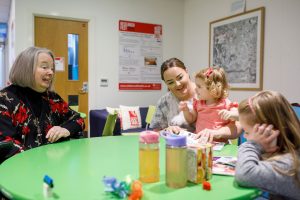What have we done so far?

At the beginning of the first part of the research programme (August 2019), we held a workshop in Bristol to devise the beliefs and behaviours questions that should be asked of the ALSPAC parents (G0s) and their 27-year-old offspring (G1s) in 2019-2020.
Questionnaires were completed by 4584 G1 offspring towards the end of 2020, and by 6844 G0 parents at the beginning of 2021 shortly before the lock-down which occurred in the UK as the result of the Covid-19 pandemic.
This provides an excellent resource, together with subsequent data being collected, to determine ways in which beliefs may, or may not, have been associated with the individual responses to the pandemic.
We have corresponded with experts in various fields regarding the further questions that should be asked in the next questionnaires and hands-on sweeps of the ALSPAC G0s and G1s. This has resulted in detailed questionnaires designed to identify: (a) facets of belief; (b) possible mediators, moderators and/or confounders. The subsequent questionnaires funded by this programme concern the mental and physical health outcomes.
Highlights from published papers
Longitudinal cohort studies like ALSPAC often suffer from the loss of participants over time. This attrition is likely to be based on a number of characteristics like age, sex, and socioeconomic background and can bias analyses of these characteristics. This selection bias occurs when the cohort of participants is systematically different from the overall population of interest. For example, if religiosity is associated with a higher likelihood of remaining in the study, then we would expect the study population to gradually become proportionately more religious over time.
Jimmy Morgan and colleagues used participation data for the ALSPAC mothers, their partners, and offspring across four different analyses to discover whether religious beliefs, religious affiliation, or religious attendance were associated with study participation. They calculated participation in four different ways: the total number of questionnaires and clinic attendances completed, a grouped version of the total completed, a binary measure of whether the most recent questionnaire (2020) had been completed, and the length of time spent in the study.
All four analyses gave similar results. Before adjusting for relevant confounders, all measures of religiosity showed some association with study participation. However, after adjustment, frequency of religious attendance was the only religious factor associated with continued participation. Mothers who attended a place of worship at least once a month on average completed two more questionnaires compared to those who did not attend at all. They were also 50% more likely to have completed the most recent questionnaire and 20% less likely to drop out of the study.
These results show that engaging in behaviours associated with religion, like going to a place of worship, may increase levels of community engagement and prosocial behaviour. However, the act of identifying as religious or believing in a divine power may not on its own provide these benefits. It is hoped that this study will contribute to the understanding of the factors affecting study participation in ALSPAC and (possibly) other longitudinal studies. Further research is needed to quantify the effect that selection bias may have on future analyses.
Morgan J, Halstead I, Northstone K, Major-Smith D. Religious/spiritual beliefs and behaviours and study participation in a prospective cohort study (ALSPAC) in Southwest England. [version 1; peer review: awaiting peer review]. Wellcome Open Res 2022, 7:186 (https://doi.org/10.12688/wellcomeopenres.17975.1)

